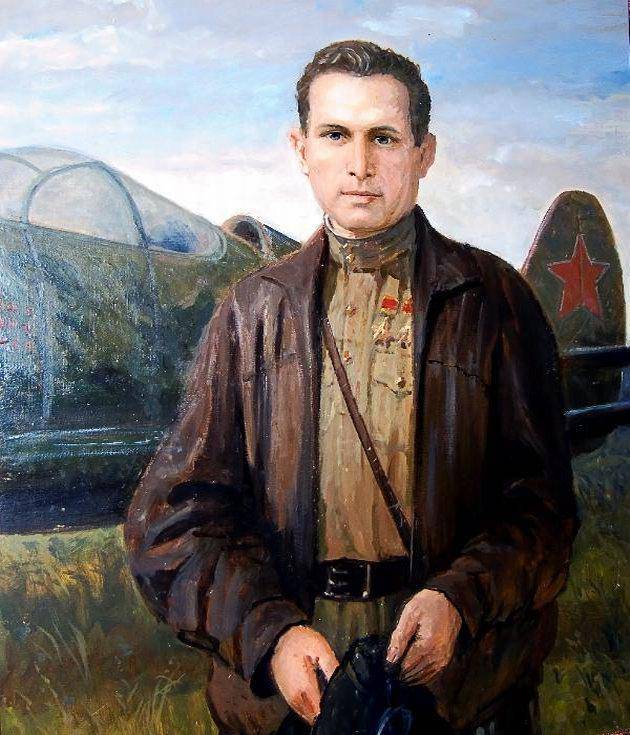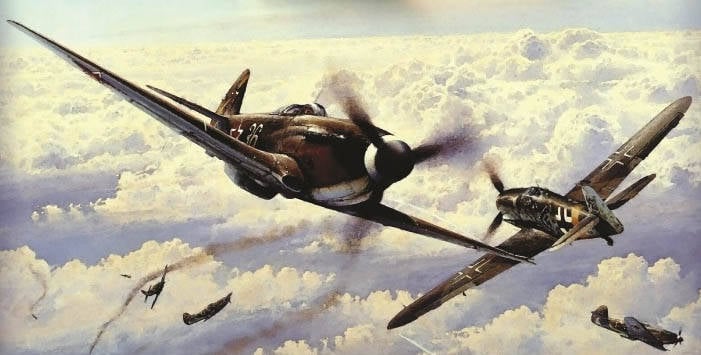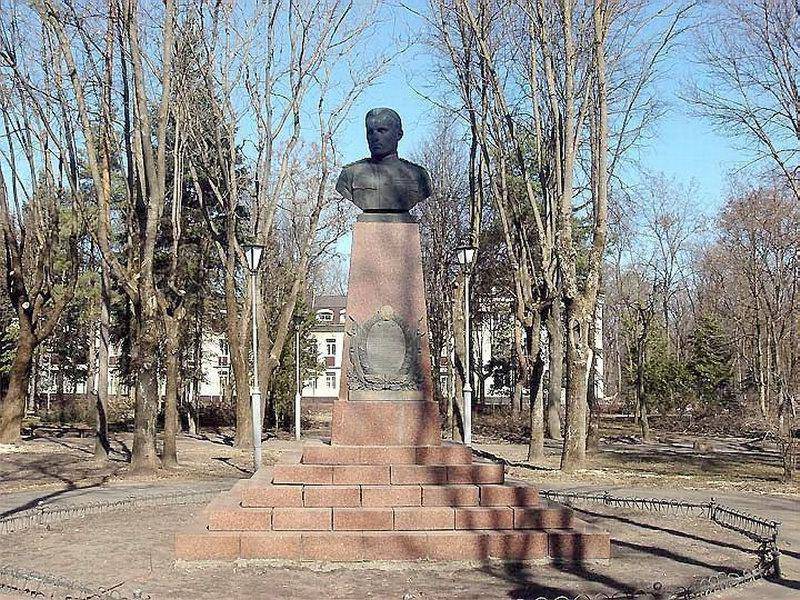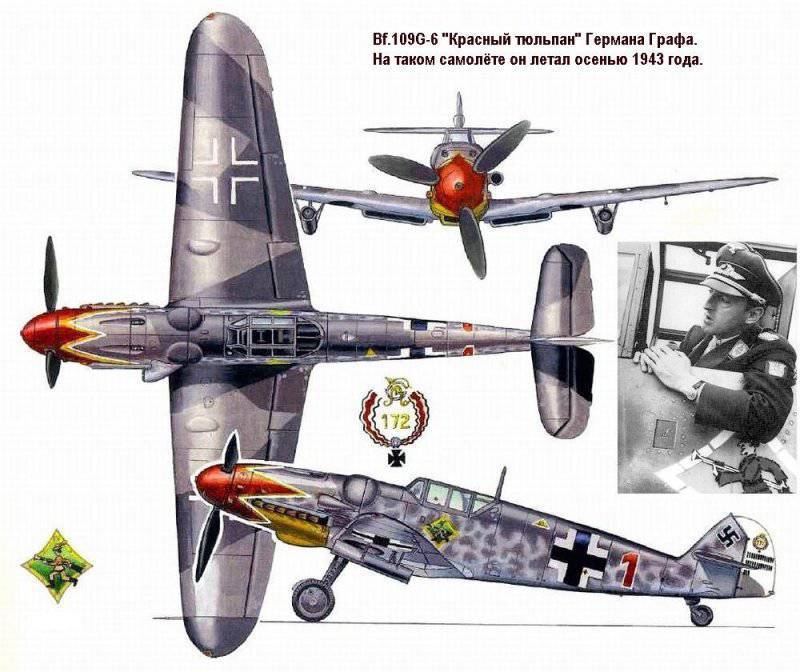Heavenly Grandmaster

Pavel Kamozin was born on July 16, 1917 in the city of Bezhitsa (now the region of Bryansk). After graduating from six grades of high school in 1931, he entered the factory school. For the first time, his flying abilities appeared in the year 1934 in an aero club at the Krasny Profintern plant (today it is the Bryansk Engineering Plant), in which young Kamozin got a job as a mechanic. In the evenings, the guy always went to the club, where he spent all his free time. Instructors immediately noted his outstanding ability to control aircraft. Since 1937, Kamozin served in the ranks of the Red Army, and in 1938 he became a graduate of the Borisoglebsk military aviation school bearing the name of the famous Valery Chkalov. After graduation, he remained to work there as an instructor pilot.
Pavel Mikhailovich met as a junior lieutenant as part of the reserve aviation regiment of the Kiev military district, which then became part of the South-Western Front. Immediately after the rally held on the parade ground, at which the German invasion was announced, Kamozin appealed to the command with a request to send him to the front. I didn’t have to wait long, already 23 June had a chance to join his first air battle with the enemy. In submission at Kamozin, who was appointed commander of the link, there were seven fighters and X-Numx. Their duties included patrolling airspace over the Black Sea coast and covering the landing of paratroopers' units. The patrols proceeded calmly, until suddenly six German Messers appeared on the horizon. The enemy confidently went towards rapprochement, Kamozin ordered the pilots led by him to close in tight formation and prepare for the attack.
Pavel always showed brilliant results when shooting in training battles, but there everything was not real, for the first time before him there was a real enemy. Later, Kamozin admitted that doubts had seized him for a second. Just remembering his own words, which he spoke to the disciples that “at the cost of even a second delay, one’s own life can become”, Paul stopped hesitating and, letting the enemy as close as possible, opened fire. The victory in that battle remained with him, but during the baptism of Kamozin was seriously wounded in the leg. The bullet pierced his foot through. At the time of treatment, Paul had to leave the front and go to the hospital in the rear. Then part of it was sent for retraining to fly the new LaGG-3 fighter jets. From the end of December, 1941 of the year and until October of 1942, Kamozin as a pilot of the 253-th reserve aviation regiment mastered the LaGG-3 piloting technique, while managing to train young pilots. More than forty aviators were released to them during this time. Finally, a year later, Paul returned to the fighting.
In a memorable battle over the village of Shahumyan, Kamozin acted as a flight commander consisting of five airplanes of the 246 th aviation regiment (LaGG-3) and two Yak-1, which were part of the 518 th air regiment. October 7 1942-year, this group of fighters began to perform the task, which consisted in covering the parts of the Eighteenth Army. Lined up in two tiers, Soviet aircraft collided with a superior German aviation group consisting of eleven Ju-87 dive bombers, four 110 "Messers" and six Me-109 covering them. According to Kamozin's plan, the five Laggovs rushed towards the German fighters, and the Yakov couple attacked Ju-87, which had begun bombing. A battle ensued, which the pilots call the “dog dump” when the battle order collapses and everyone acts independently. Soon, the battle spread to bends, where domestic LaGGi had an advantage over Me-109. Despite the numerical superiority of the enemy, in ten minutes of the air duel, the pilots who joined the Kamozin group managed to destroy eight German aircraft, three of which were shot down by the flight commander himself. However, the victory was not easy, our losses amounted to four aircraft.

It was during this period that Paul also managed to take part in air operations along with a pilot, Lieutenant Colonel Dmitry Leontievich Kalarash, who had become famous in prewar times, whom he considered one of his teachers. The brave fighter pilot died in one of the fights in November of 1942. But Pavel Mikhailovich always remembered and loved to repeat to his students his words that “the pilot's heart must be made of steel, so courageous that it does not tremble, even if the seat in the plane has a wooden back”.
At the end of the 1942 year, Kamozin was appointed deputy squadron of the 269 th Fighter Regiment. During the first month of the fighting after his return to the front, the brave pilot managed to shoot down four Nazi aircraft, among which was the well-equipped Do-217. By the beginning of March 1943, the number of enemy planes destroyed by Paul reaches twelve. They were shot down during twenty-three air battles. By that time, he already had eighty-two combat sorties. The victories strengthened Kamozin’s confidence in his abilities, made him famous, and helped his commanding authority strengthen.
In the spring of 1943, after heavy fights with the enemy, the 269 regiment lost a significant part of the equipment, and therefore was sent to the rear and disbanded. 1 May 1943 for his courage, resourcefulness and heroism in the battles with the fascists, Pavel Kamozin was awarded the title "Hero of the Soviet Union." He was awarded the Order of Lenin, as well as the “Golden Star” of the Hero. With each successive act, the pilot confirmed that he received this title not in vain. After the regiment was disbanded, being in the rear of 1943 in the summer of the year, Kamozin was among the first to master a new American-made F-39 fighter named “Air Cobra” and continues his fight with the enemy already as part of the sixty-sixth IAP of the fourth air division army. In the very first battle, Kamozin knocks down the German FW-329 reconnaissance aircraft, but his Air Cobra receives serious damage from anti-aircraft artillery fire and the pilot has to urgently land the fighter in the neutral zone, and then independently reach the trenches of the Soviet units.
It should be noted that in addition to patrolling the territories, covering ground Soviet units and attack aircraft, Kamozin often had to make reconnaissance missions. The data obtained by him during the flights were always confirmed and helped to destroy significant enemy forces. So in January, the 1943 of the year at the airfield of Krasnodar, the pilot was able to detect enemy aircraft of about fifty units. After Paul’s urgent report on the discovery, Soviet attack aircraft, which had risen into the air, were able to destroy about two dozen fascist aircraft. Soon, having appreciated the skill of an experienced pilot, the command appoints Pavel Kamozin as a squadron commander.
Another noticeable battle took place when Kamozin’s group of five fighters, returning to the base, found thirteen “Junkers” who had taken off to bombard our units. Suddenly attacking enemy planes, the pilots forced the Germans to bomb a little earlier than the intended target. As a result, part of the bombs fell on the position of the Nazis. The confused, scattered group of German aircraft attempted to turn around and leave, but Kamozin had completely different plans. In that battle, he personally shot down one enemy plane and shot down the other two. His subordinates, who also destroyed two more German bombers, quickly found their way in the situation.
Co-workers respected and loved Pavel Mikhailovich, admiring his martial skills. The special audacity and assertiveness of Kamozin in the conduct of air battles always brought results. He did not frighten the fascists, he beat them with a short aiming shot from close range, shot at close range. Soon this handwriting became recognizable in the camp of the enemy, the German pilots startled at the thought of meeting him. Kamozin’s dedication and talent were especially vividly displayed in the fierce battles for the liberation of glorious Sevastopol, when sixty-four enemy aircraft were shot down by his squadron, nineteen of which were destroyed by the commander himself.
The day of December 31 of 1943 became remarkable for Pavel Mikhailovich. Kamozin and his permanent wingman Vladimir Ladykin, who had taken off for reconnaissance, were already returning home, but they noticed a group of six German Me-109 fighters accompanying a transport plane in the area of the Seven Wells village. In Paul’s head, the thought immediately arose that such an honor would not have been given the usual weight. Having approached at maximum speed and not letting the protecting Messers recuperate, Kamozin walked in a long queue along a guarded transport worker, who immediately tilted and began to fall. And two Soviet fighter quickly dissolved in the evening sky. And only three months later, Pavel learned that on board the plane he had shot down, German generals were flying to a celebration in honor of the New Year, who were carrying honorary awards for especially distinguished soldiers. The holiday at the fascists was spoiled, and in the German troops mourning was declared for several days.
Bold attacks and successes Kamozin could not go unnoticed in the camp of the enemy. The destruction of a group of high-ranking Fritz overflowed the patience of the German command. A real hunt was announced for the brave pilot, according to some information it was assigned to one of the most experienced fighters of the “diamond” squadron Goering, the first pilot in the world who won more than two hundred victories, the pilot named Herman Graf. He distinguished himself in battles in the skies of Western and Eastern Europe, his style was characterized by particular aggressiveness and ruthlessness. Dozens of downed Soviet aircraft were listed on the account of "The Auburn Ace", he commanded an entire tactical school to retrain German pilots arriving from the front. Having learned about the plans of the Nazis, the Soviet commanders rushed to warn Kamozin. The authorities directly told him: “The best pilots from the aerobatics school in Berlin have announced a hunt for you. Colonel Graf was ordered to destroy Chief Lieutenant Kamozin by any means. You are allowed for ten, fifteen days, twenty days not to fly, to rest. ” Low, stocky Paul calmly replied: "And why should he hunt me, and not me, this Count?" The bosses in reply: “We cannot order you, the pilot must make a decision himself”.
Well aware that the battle would be far from easy, and the destruction of the Count could significantly affect the morale of German aviators and soldiers, Kamozin began to prepare for a meeting with the enemy, studying his tactics at his leisure, assessing all the known strengths and weaknesses, working with his wards and negotiating with them about all the details of the interaction in battle.
And the meeting with Kamozin Graf still took place. It happened when four Soviet fighters returned after patrolling to their airfield. The Soviet pilots, like the German ones, knew all the callsigns of especially famous aces like Pokryshkin well. Despite the fact that there was very little talk on the radio when the air battle was going on, everything was "directly." Our ground service had time to warn Paul about the appearance of the Earl, and the pilot decided not to evade the attack. In the head of Pavel, the original and bold plan to destroy the enemy has long been mature. Leaving a couple of his followers behind, he ordered them to rise to a height of six and a half thousand meters and carefully watch around. And he went on. The count gained a height of about five thousand meters, Kamozin, three or four hundred meters below, circling, approached the enemy as close as possible. His idea was to expose himself under the blow. As the experienced pilot had hoped, the Count was seduced by the opportunity to come to his tail, and as soon as the chance presented himself, he immediately attacked the Soviet fighter. Pavel began to walk away from the fire, abruptly, in the manner of Pokryshkin, removed the gas and left the sight of the German pilot, who decided that he was continuing to go at high speed. After that, Kamozin made a controlled barrel and went out a couple of hundred meters in the tail of the Count's plane, attacking him straight off. Switching attention to defense, the German began to go up sharply, to gain altitude, but there a couple of Kamozin-led ones were already waiting for him. Seeing them, the Earl turned down again, and Pavel’s fighter aircraft flashed a German plane, which began to fall apart right in the air.
For a long time, our pilots thought the German colonel was dead, but it turned out that he managed to jump at a low altitude with a parachute. When news of this reached Göring, he sent an order to the pilot to go back to school with the words: "You cannot be left there anymore, and then they will finally kill everyone." And Pavel Kamozin wrote a letter to his family that day: “The time is hotter now. Every day, intense battles. We have learned to hate the enemy and mercilessly destroy him. ”
The combat technique that the squadron commander liked to use was always distinguished by daring, stunning adversary attacks. Owning perfectly all the aerobatics, Kamozin was able to quickly navigate in the current situation and choose the most appropriate techniques. He improved daily in his business, the high skill of the pilot helped not only to successfully fight a dangerous, insidious and well-trained enemy, but also saved the lives of his comrades more than once. In one of the battles, the young ward of the commander, Lieutenant Toichkin, missed the moment when one of the enemy's Messers settled down at the tail of his plane and prepared to attack. But Kamozin managed to open fire for a moment before the German and thereby saved the life of the pilot. After this air battle, Paul was presented to the Order of the Patriotic War, I Degree. At the beginning of winter, 1944, in fierce battles with German planes, the pilot managed to shoot down two more German aces. By the summer of 1944, in the individual competition, which had already become captain of Pavel Kamozin, there were twenty-nine downed enemy aircraft, thirteen units were destroyed in groups with his participation. At that time he conducted fifty-six air battles and made one hundred thirty-one combat sorties. For his outstanding achievements in July 1 1944, the government presented him to the second “Golden Star” of the Hero.
However, among the valiant and victorious pages of the biography of a brave fighter were both difficult periods and frank failures. A couple of times he had to plant a burning car, barely reaching its territory. Once he "drove down" a padded fighter into the water in the sea. He was rescued by the staff of the medpost, located on the Tuzla Spit. There was also a nosing (flipping of a fighter onto the back through the head) on a split runway shells. Miraculously surviving, Paul always managed to find ways out of even the most difficult situations, analyze what happened to him and draw the right conclusions. And as if by a twist of fate, he could not find a common language only with the authorities. And during the war years in the flight troops, there was an order to punish pilots for the slightest violation of discipline, despite their merits, up to and including dismissal from the army. In 1944, direct management wrote a report to Pavel, after which he was first removed from his position as commander of the squadron, and later, after the war, and completely dismissed from the army.
20 January 1945 of the year Pavel Kamozin suffered another accident on his Aerocobra, the engine went out and the car slowly fell to the ground. The pilot was fantastically lucky, he was still alive, but he received very serious injuries to the lower part of the body that threatened him with an amputation of his left leg. However, risking his life, Pavel Mikhailovich insisted on the preservation of his limb, his willpower helped to avoid the operation, after which he would have remained crippled. Victory May Day Kamozin met in the hospital ward.
After the end of the war, from the 1946 year, Pavel Mikhailovich Kamozin continued to work, but already in civil aviation, teaching young pilots. This brave man left 24 on November 1983 of the year. The hometown of Bryansk remembers his heroic compatriot - a bronze bust of the hero was installed in one of the parks, and from 1985 of the year the aviation club, where Kamozin once worked, bears his name. In addition, the name of the talented hero pilot named one of the streets of the city, and the Pavel Kamozin Museum was founded at school number XXUMX.
Fighting on the North Caucasus, Transcaucasian, Southern and other fronts, Pavel Kamozin made about two hundred combat sorties, in merciless air battles he won forty-nine victories: he personally destroyed thirty-six enemy planes and thirteen together with his comrades. Many historians say that thirty-six airplanes are far from all that a brilliant pilot actually shot down ....

Information sources:
-http: //www.warheroes.ru/hero/hero.asp? Hero_id = 1108
-http: //airaces.narod.ru/all1/kamozin1.htm
-http: //www.airwar.ru/history/aces/ace2ww/pilots/kamozin.html
-http: //www.peoples.ru/military/hero/pavel_kamozin/


Information